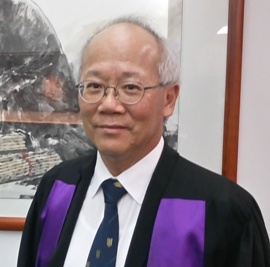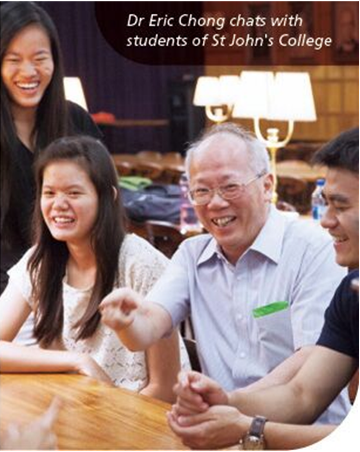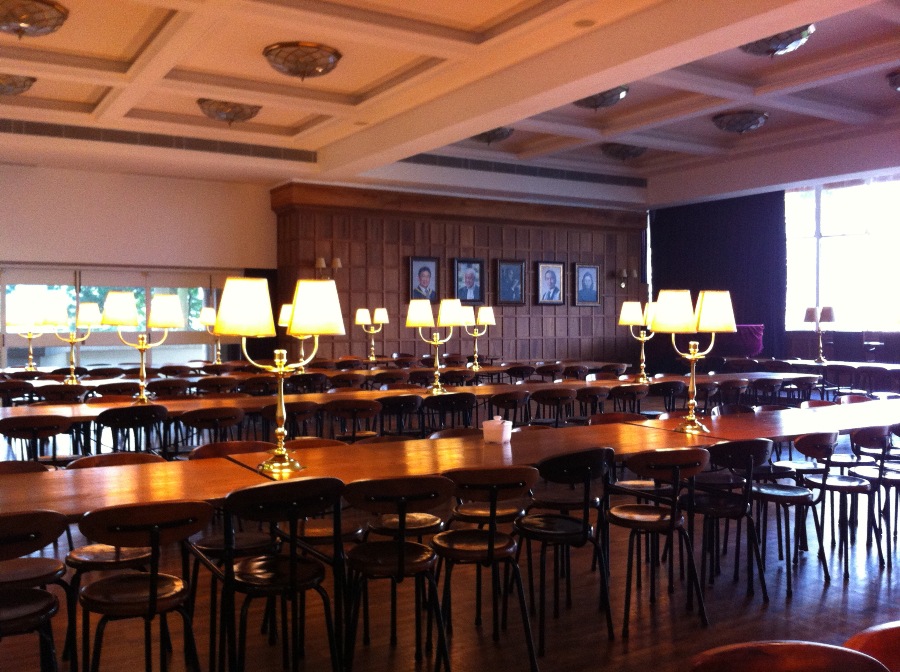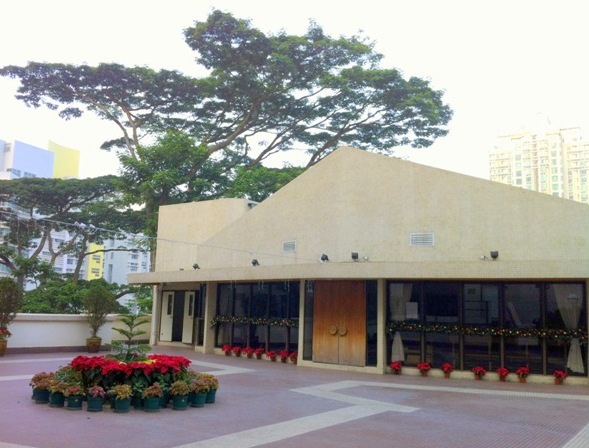<閱讀中文撮譯,請點按此處>
Interviewed and reported by Terese Wong (St Stephen's Church)
|
At the hillside to the west of the new Centenary Campus of the University of Hong Kong stands a hall of university student residence - St. John’s College. It is the only secular tertiary institution established by the Anglican Church that has remained closely connected to Hong Kong Sheng Kung Hui. We have interviewed its current master, the Reverend Canon Dr. Eric Chong Chee-Min, to understand more about its history and its relationship with Hong Kong Sheng Kung Hui’s mission in education. |
College Emblem
The full name of St. John’s College is the College of St. John the Evangelist. Its emblem is the Aquila - the Latin Eagle, which is also the symbol for St. John the Evangelist. |

"St. Johnians would see things differently and engage themselves in the world with insights in both local and international dimension." |
St. John’s College’s history went back to 1912 when its predecessors were established, namely St. John’s Hall and St. Stephen’s Hall, which were for boys and girls respectively. They were established by the Church Missionary Society under the auspices of the Church of England as part of its evangelical and mission work through education. The halls of residence were built to provide accommodation for students primarily from the Church schools, such as St. Stephen’s College and St. Paul’s College.
Canon Chong explains that “the College is more than a hall of residence. "College" better represent our mission – a College is the gathering together of a body of scholars for the formation of human character through sports and cultural activities, and the pursuit of academic excellence by discipline study and open discussions.” It has long been the mission of the College to train new leaders for the society. Generations of students of the halls had made notable contribution to the society, which include serving in the Second World War in both active service and in taking care of refugees. After the Second World War in 1955, the halls were relocated and combined to form the present St. John’s College at the junction of Pokfulam and Pokfield Road. The College continued its mission under the banner “Breeds the Excellent”, and had through many years nurtured many of Hong Kong’s leaders in government, industry and commerce, culture and education. The College built a new wing in 1979 responding to the increasing need of the growing University of Hong Kong and in 1997 it was further expanded when a graduate wing was built to provide accommodation to postgraduate students.
When asked how is the College administered, Canon Chong explained that the mode of administration of the College took the model of university colleges run by the Church of England in the United Kingdom, where the residential colleges become part of the university but yet are financially and administratively independent. Thus St. John’s College has an independent administration from the University of Hong Kong and at the same time working closely with the university. The College also remains closely associated with the Church. Apart from alumni and fellows of the College, its council members also include representatives from the Hong Kong Sheng Kung Hui and the vicar of the parish as well as principals of Anglican schools. Canon Chong considers that the Church’s involvement is important to nurture students in their character formation with Christian values.

"...a College is the gathering together of a body scholars for the formation of human character through sports and cultural activities, and the pursuit of academic excellence by discipline study and open discussions..." |
The operation of the College is modeled after the Oxbridge System in UK. The Master together with the Dean lead a team of fellows and tutors to provide supervision to the resident students in their College life and academic study. The tutors are recruited by the College and trained by the university as tutor counselors to provide guidance and directions to resident students: there are residential tutors on each residential floor to help build community life and counsel residents to adapt to tertiary education and character formation to enable the students to become full member of the College community. While the students, being full member of Hong Kong University, would receive academic instructions and supervision from the University, the College also has a team of academic tutors to provide additional support giving guidance and direction in their study through various means, ranging from organizing study groups to one-to-one guidance. The tutors are mainly alumni and post-graduates and provide the services on voluntary basis only with a token honorarium. This unique tutoring system also attracts many alumni from other halls who wish to contribute in nurturing their juniors. This system helps foster a network of scholars and establish links with other universities overseas as the College also receives visiting professors and graduates from other universities, such as Cambridge University and Oxford University, offering their service to the University and the College. |
Responding to the question of the image of the College as an exclusive college for the affluent and elite class, Canon Chong acknowledges that the College has often been perceived as a college for the elite, however, he clarifies that it is both “a myth and a fact”. He explains that in the early days in Hong Kong, only the affluent class could afford to send their children to study at universities. However, the Anglican Church had awarded scholarships to subsidize many outstanding students with financial difficulties to enable them to further their studies, many of them have made considerable contribution to the society in return after they graduated. Thus the College could be considered as elite academically but not economically or financially. Canon Chong further explains that the College’s image of intellectual excellence gives the students and alumni a sense of identity and pride as well as fostering an aspiration for the younger generation to become a St. Johnian.

Dining Room
The College holds weekly "High-Table" dinners in the tradition of the Oxbridge model during term time, where all students would participate to socialize with other St. Johnians. High-Table Talks will be held from time to time to encourage social engagement, inviting prominent figures in the society, many of whom are also alumni of the College, to give talks on broad range of topics from politics to community services.
When Canon Chong is asked what he sees as the challenges to students nowadays, he shares the difficulties encountered in the transitional period in Hong Kong’s education reform with the introduction of the Hong Kong Diploma of Secondary Education (commonly referred to as DSE) system. Under the new "3-3-4" education system, students enter university at an age one year younger than students under the previous system. Canon Chong sees that the age gap means that first year students are mentally and emotionally less mature than their predecessors. The College found itself facing the challenge to prepare the younger students emotionally and psychologically to ride through the transition from a previously more “programmed and planned” life under close school and parental supervision in high school and learn to live more independently with little parental supervision and dependency. The College itself had undergone reform in its College life in the past three years putting more emphasis on character formation initiatives for the students to learn self-management and social skills. Canon Chong stresses that the role of the College was not to act as “loco parentis” assuming the role of a parent, the question is to find the balance to help the students to grow up and mature to independence.
The Hong Kong Sheng Kung Hui has established a School Education Policy Paper, which is mainly concerned with primary and secondary school education. When asked whether he thinks the Church policy on education is also relevant to tertiary education, Canon Chong expresses that he finds the policy paper to be one of the best policy papers of the Church and feels that education should be part and parcel of the Church’s mission and vision. The ideal vision for St. John’s College is to nurture a “Renaissance man” - he explains that “a Renaissance man is a polymath with diverse expertise intellectually and socially with a broad world vision.” He hopes that “St. Johnians would see things differently and engage themselves in the world with insights in both local and international dimension.” He sees that it is important that such a person should embody Christian values and ethos. Therefore St. John’s College must work closely with the Hong Kong Sheng Kung Hui to achieve its vision: the student body of St. John’s College comprises of diverse background with local and non-local students from the Mainland and overseas. The parish churches could play an important role in bridging the Church with the College: the nearby local St. Stephen’s Church is well placed to foster a local family feeling with its Cantonese speaking congregation and St. John’s Cathedral provides English speaking and Putonghua services for the non-local students. Canon Chong also sees that Christ Church, in which he is the associate curate, could provide a link with the expatriate community for international scholars. He appreciates that Hong Kong Sheng Kung Hui clerics have been supportive to the College through St. John’s chaplaincy, he hopes that closer bondage could be established with more involvement by ordained clerics from the parishes.
 |
 |
The Chaplaincy
St John’s College has a built a chapel – Chapel of Epiphany, for students and staff of the College for prayers worship and reflection. It is established in the Anglican tradition with an ecumenical outlook to serve the wider community based on a Christian faith that transcends difference in race, nationality, colour, gender and social backgrounds, traditions and denominations.
The Chapel holds regular prayer services during the term, and organizes bible study group, fellowship and other seasonal worships.
The College currently has two lay Chaplains, one in resident and one part-time. The Chaplains provide support to members of the College by listening to their concerns and giving guidance in spiritual matters and college life. |
The College Hymn
College Hymn of St. John’s College is adapted from a classic English hymn “Jerusalem” with lyrics inspired by William Blake’s poem, c. 1808.
- And did those feet in ancient time
Walk upon Hong Kong’s mountains green?
And was the holy Lamb of God
on China’s pleasant pastures seen?
And did the countenance divine
shine forth upon our clouded hills?
And was St John’s College builded here
among these dark majestic hills?
Bring me my bow of burning gold!
Bring me my arrows of desire!
Bring me my spear! O clouds, unfold!
Bring me my chariot of fire!
I will not cease from mental fight,
nor shall my sword sleep in my hand,
till we have built Jerusalem
on St John’s green and pleasant land. |
College Mission
- To foster St.Johnians to have all-round and distinguished character.
- To make the St. Johnians zealous for the College and society.
- To encourage St.Johnians to become a life-long member of the College fraternity and community.
College Motto
ΠΑΝΤΑ ΔΙ ΑΥΤΟΥ
"All Through Him" |
<For English,
please click here>
採訪、原文:王紫珊(聖士提反堂)
撮譯:姚子健(北角聖彼得堂)
聖約翰學院矗立在香港大學百周年校園以西的山麓,這所學院是香港大學眾多學生宿舍中,唯一與香港聖公會在高等教育的使命和服侍維繫着密切關係的大專學院。今期《網絡》特意採訪了聖約翰學院院長張志明法政牧師,跟讀者分享學院的歷史與香港聖公會的教育使命的關連。
聖約翰學院與香港聖公會
聖約翰學院的歷史追溯至1912年,當時英國海外傳道會(Church Missionary Society)為服侍在教會學校就讀的莘莘學子,並希望藉教育宣揚福音,於是成立了聖約翰院舍及聖士提反院舍,向就讀當時教會創立的學校(如聖士提反書院及聖保羅書院)的學生提供宿舍。
「聖約翰學院不只是一所宿舍。」張法政牧師開宗明義點出這事實。學院代表着我們的教育使命──她是滙聚一眾學者的地方,透過體育活動、文化交流培育學生的全人發展。透過學術討論與刻苦進修,學生皆以謀求卓越為念。學院多年來為香港社會培育了不少精英分子,回饋社會。當中包括在大戰時期入伍為國捐軀的及賙濟難民的義士。戰後,聖約翰學院遷到薄扶林道的現址,繼續其「培英育才」的教育使命,培育了不少香港的領導人才,在政府、工商界服務社會。1979年,學院加建新校舍以配合香港大學的發展;在1997年更進一步擴充,建研究生宿舍。

學院採納劍橋牛津傳統,每星期都有高桌晚餐。當中同學可與院友交流。不時也有高桌講座,邀請社會各界人士 (其中不少是舊生)對不同社會議題作分享,以增進社會關注和參與。
另外,學院的管理及財務完全獨立於大學,張法政牧師解釋此行政模式是採納英國聖公會創立的大學學院的模式。 因此學院與香港大學保持緊密聯繫之餘不失其獨立自主,與此同時也與香港聖公會維持着密切關係:校董會的成員除了舊生參與其中,也包括聖公會的牧者及牧區學校的校長。 張法政牧師認為,教會在學院的參與,在彰顯基督教價值觀以造就學生的品格尤其重要。
獨特的導師制度
張法政牧師指,學院採納劍橋牛津的師承模式,在院長和副院長帶領下設有駐校導師團隊。透過個人指導或小組討論,無論是學業上,或是生活適應上為同學提供指導。宿舍每個樓層都有駐院導師,幫助學生適應學院的羣體生活及專上學院的制度,以至他們能成為真正大學生的一份子。這些導師都是義務幫助學院,大都是舊生。學院的獨特模式,甚至吸引了來自其他學院的畢業生來充當導師,他們都抱着薪火相傳、扶掖後進的心志,與這些同學同行。這種聯繫使學院能與其他海外大學(如英國的劍橋大學、牛津大學等)增進交流,同學可以與來自外地的教授學者互動,建立網絡,擴闊視野。
就着聖約翰學院被冠以「精英名學府」的稱號,張志明法政牧師回應指,在早期香港,普遍只有在經濟上有能力的才能入讀大學,然而當時聖公會則向經濟上有缺乏的高材生授予獎學金以助其成材,其中不少畢業後能努力回饋社會。故此,張法政牧師認為聖約翰學院確實是培育精英的學院,但斷不是一所貴族學院。他進一步解釋,學院學術精湛的名聲,能幫助學生對自己的身份有一定認同及引以為榮,也望能令後輩以此為理想之目標。
問及他認為學院時下面對甚麼挑戰時,張法政牧師直言,在香港的教育改革政策當中,各方都面對不少轉換期的挑戰,現在升讀大學的同學都是「三三四」新學制下的中學畢業生。比起以往經歷過中學會考及預科的師兄師姐,這些大學新生早了一年入讀大學,這意味着他們需要更多的心理準備迎接大學生活。中學時,學生需按照時間表上課,老師會督促同學完成課業;升讀大學後,同學享有更多的自由和彈性,教授也不會像中學老師般「貼身監察」。張法政牧師指,學院在過去三年新學制的過渡期間,致力幫助同學盡快投入大學生活,並學會自我管理和社交技巧。他強調「我們的角色並不是『代位父母』(loco parentis),而是希望與同學同行,引導他們自立,在解難的過程中成長。」
救主乃是學校根基
《香港聖公會教省教育政策文件》在六年前的教省總議會上通過。雖然當中主要涉及中、小學,但張法政牧師指,此政策文件表明在教會宣教及培育上,教育實在是不可或缺的一環,因此也能應用在大專教育上。「我們對聖約翰學院的畢業生均寄予厚望,希望他們都是『文藝復興人』(Renaissance Man):博學多聞,勇敢入世,同時具備本地及國際視野的通才。」他認為要成為這樣的卓越的新人類,必須具備基督教價值觀與道德觀。因此,學院必須與教會維繫緊密的合作。學院的學生來自四海,不同牧區分別有助不同學生的需要,聖士提反堂能為本地生提供一個屬靈的家,而聖約翰座堂則能照顧說英語及普通話的學生,甚至在張志明法政牧師所屬的基督堂也可為海外學者與外籍教友作橋樑。張法政牧師感激先哲前賢為聖約翰學院的一切努力,並展望在上主的帶領下,教會與學院的合作能更為緊密。
聖約翰學院設有小聖堂名為「基督顯現小聖堂」,供師生敬拜、祈禱及反思之用。是依循基督教聖公會的傳統設立,認信上主的愛是普及世人,是超越種族、國界、膚色、性別和階層的,並尊重不同的信念、信仰傳統及教派。在學期間,有定期的早晚禱,此外也安排查經小組、團契活動及節期崇拜等。學院現有兩位駐院及半職平信徒義務院牧。院牧對學院師生在學院生活中,透過聆聽及關懷,在靈性上給予支持及啟導。
聖約翰學院使命:
1. 培育全人的發展,建立卓越品格。
2. 促進院生熱衷學院及社會。
3. 鼓勵院生建立深遠的同仁共濟社羣。
聖約翰學院的座右銘:
ΠΑΝΤΑ ΔΙ ΑΥΤΟΥ - 希臘文,解作「 藉着衪」。